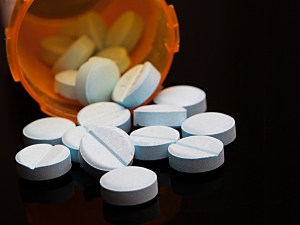One of the goals of the newer “all-inside” surgical techniques for anterior cruciate ligament reconstruction (ACLR), which don’t involve full bone-tunnel drilling, is to reduce the postoperative opioid requirement. To help address the crisis of opioid misuse and overdoses in the U.S., orthopedic surgeons are being called on to minimize leftover opioid medication and prescribe non-opioid regimens whenever possible.
Eli T. Sayegh, MD, a former sports medicine fellow in the Department of Orthopaedic Surgery at Brigham and Women’s Hospital, Elizabeth G. Matzkin, MD, surgical director of Women’s Musculoskeletal Health and chief of Women’s Sports Medicine in the department, and colleagues recently set out to define the opioid requirement for all-inside ACLR.
In the Journal of the AAOS: Global Research and Reviews, they report effective pain control with a multimodal analgesia regimen that included a limited opioid taper of 15 tablets for five days, which had no negative effect on patient satisfaction.
Methods
The researchers retrospectively analyzed prospectively collected data on 108 adults who underwent primary arthroscopic ACLR with hamstring autograft or allograft between January 2017 and October 2020.
After surgery, patients received prescriptions for acetaminophen and either ibuprofen or naproxen. They were also prescribed a 20-tablet supply of either oxycodone 5 mg or tramadol 50 mg, with instructions to use the drug only if needed for severe pain.
Preoperatively, patients were asked to predict what their pain would be 48 hours after surgery (scale 0–100). They used the same scale to rate their pain on the first postoperative day and at the two-week follow-up visit. Patients also rated their satisfaction with pain management at the two postoperative time points. At the two-week follow-up, they reported on their consumption of opioid and nonopioid medication.
Patient Characteristics
57% of the cohort was female and the mean age was 35 (range, 18–66). 95% of patients were opioid-naïve before surgery. On average, patients expected to have moderate pain after ACLR (the mean preoperative rating of anticipated pain was 69).
Satisfaction With Pain Management
71.3% of patients said they were “always” or “usually” satisfied with how well their pain was controlled after ACLR reconstruction surgery. Preoperative pain expectation did not influence satisfaction with pain control.
Pain Medicine Consumption
Most patients used both nonopioid and opioid medications postoperatively. 94% took acetaminophen, ibuprofen and/or naproxen after surgery, and 93% took at least one opioid tablet. However, 7% used no opioid medication. The mean duration of opioid consumption was 5.3 days and the mean cumulative intake was 15.3 tablets.
Patients who were using an opioid at the time of surgery:
- Consumed twice as many opioid tablets as opioid-naïve patients (29 vs. 15 tablets; P=0.0280)
- Remained on opioids twice as long after surgery compared with opioid-naïve patients (10 vs. 5 days)
Predictors of Greater Opioid Use
In multivariate analysis:
- Predictors of using more opioid tablets were any prior surgery (P=0.0340) and preoperative opioid use (P=0.0480)
- Predictors of longer duration of opioid use were preoperative pain expectation (P=0.0414) and preoperative opioid use (P=0.0110)
Recommendations for Prescribing Clinicians
A recent study of patients who underwent arthroscopic knee surgery, published in The Orthopaedic Journal of Sports Medicine, came to a similar conclusion as this one: the authors recommended a maximum of 20 opioid tablets for one week. Multiple other studies have demonstrated that relatively few patients recovering from knee or shoulder arthroscopy request a refill for their opioid prescription.
Prescribers should therefore err on the side of minimizing unused tablets, as this will reduce misuse and diversion without being likely to generate a high number of refill requests. They should also target preoperative education and expectation-setting to at-risk patients, including those with heightened preoperative pain expectations and those using an opioid preoperatively.
